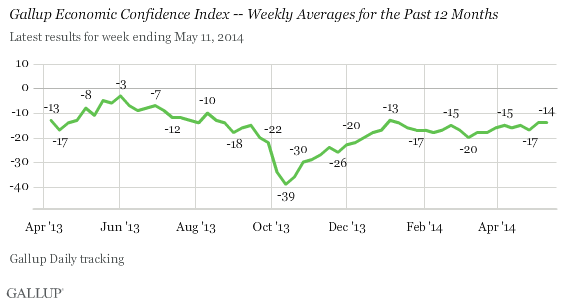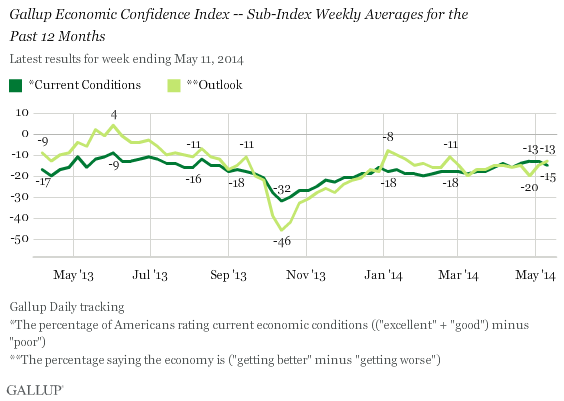WASHINGTON, D.C. -- Gallup's U.S. Economic Confidence Index held steady at -14 last week after inching up three points the week before. This index is toward the upper end of the narrow range measured this year -- from -20 to -13 -- and remains significantly higher than it has been at most points since 2008. However, the index still trails the weekly tracking high of -3 found in late May and early June of 2013.

Americans' views of the economy have been more stable so far this year than last year. The fiscal cliff deal at the 11th hour, automatic budget sequestration, and the federal government shutdown all shook economic confidence in 2013, while this year has generally been devoid of partisan brinkmanship on major federal budget issues. At the same time, real-world economic indicators, such as high stock market prices, job creation, and generally positive BLS unemployment reports have not been enough to propel the index into positive territory.
Currently, 35% of Americans say economic conditions are "poor," while 20% categorize them as "excellent" (2%) or "good" (18%). The difference results in a current conditions rating of -15, down two points from the prior week's -13 and similar to recent weeks. The remaining 45% call current conditions "only fair."
Looking forward, 54% of Americans perceive the economy to be "getting worse," while 41% say it is "getting better." The difference results in an economic outlook rating of -13, up two points from the prior week's -15, but on par with recent weeks.
Americans' ratings of current economic conditions have improved slightly since January, while their outlook has worsened a bit. Overall, views of both aspects of the economy have remained steady this year compared with previous years.

Implications
With six months to go before the congressional midterm elections, Americans' views of the economy will be a key factor in determining the election outcomes. Midterm elections are often a referendum on the president and the state of the economy. Therefore, economic confidence readings late in an election season can be an important signal for Democrats this year, since voters tend to take out economic frustration on the president and his party, while a more upbeat view of the economy may bode well for Democrats.
The current reading provides mixed signals for Democrats in the midterms. While the current economic confidence reading of -14 is significantly better than most measurements since 2008, economic confidence is still entrenched in negative territory and generally has not moved much this year. Democratic candidates could seemingly benefit from touting upbeat economic news, such as strong stock market performance, lower unemployment, and more job creation, but these improvements are not important factors unless the voters recognize them. And so far this year, there is no indication of a sharp rise in consumer confidence. Americans may need to see more improvement in the unemployment rate, more economic growth, and continued improvement in other key economic indicators before consumer confidence moves significantly higher.
Gallup.com reports results from these indexes in daily, weekly, and monthly averages and in Gallup.com stories. Complete trend data are always available to view and export in the following charts:
Daily: Employment, Economic Confidence and Job Creation, Consumer Spending
Weekly: Employment, Economic Confidence, Job Creation, Consumer Spending
Read more about Gallup's economic measures.
View our economic release schedule.
Survey Methods
Results for this Gallup poll are based on telephone interviews conducted May 5-11, 2014, on the Gallup Daily tracking survey, with a random sample of 3,553 adults, aged 18 and older, living in all 50 U.S. states and the District of Columbia.
For results based on the total sample of national adults, the margin of sampling error is ±3 percentage points at the 95% confidence level.
Interviews are conducted with respondents on landline telephones and cellular phones, with interviews conducted in Spanish for respondents who are primarily Spanish-speaking. Each sample of national adults includes a minimum quota of 50% cellphone respondents and 50% landline respondents, with additional minimum quotas by time zone within region. Landline and cellular telephone numbers are selected using random-digit-dial methods. Landline respondents are chosen at random within each household on the basis of which member had the most recent birthday.
Samples are weighted to correct for unequal selection probability, nonresponse, and double coverage of landline and cell users in the two sampling frames. They are also weighted to match the national demographics of gender, age, race, Hispanic ethnicity, education, region, population density, and phone status (cellphone only/landline only/both, and cellphone mostly). Demographic weighting targets are based on the most recent Current Population Survey figures for the aged 18 and older U.S. population. Phone status targets are based on the most recent National Health Interview Survey. Population density targets are based on the most recent U.S. census. All reported margins of sampling error include the computed design effects for weighting.
In addition to sampling error, question wording and practical difficulties in conducting surveys can introduce error or bias into the findings of public opinion polls.
For more details on Gallup's polling methodology, visit www.gallup.com.
